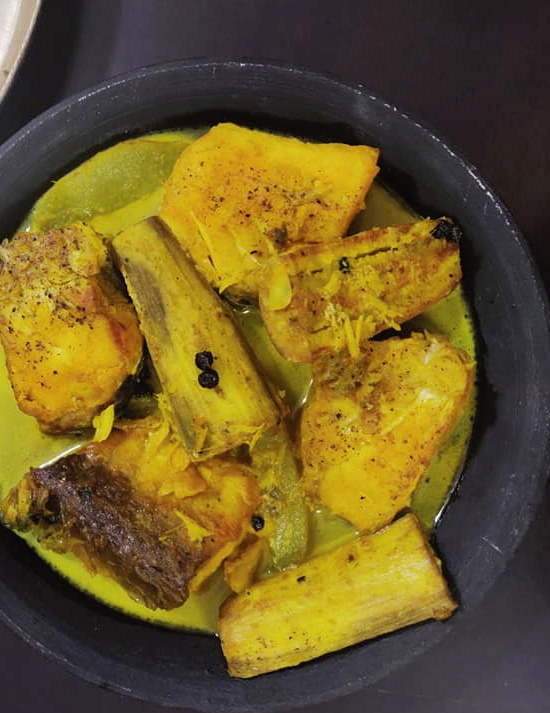Paka Machher Morich Pora Jhol – Carp in light black pepper stew

The afternoon sun in Delhi is already showing it’s true colour after being subdued by an extended winter. It is not long before it will be impossible to imagine that Delhi was cold a few months back and it will be cold again, though not sometime soon!
The diet in this period of changing seasons demands to be fortifying for the body and one that helps the body come out of winter hibernation just as the earth springs back to life with longer days and brighter sunlight. Ayurveda says that it is the season for ‘kapha’ dosha. The season brings allergies and chest infections. The food prescribed to balance kapha and fight these seasonal changes are bitter/astringent, spicy/pungent, vegetable and protein broths, especially lean protein, light, dry and warm. Ginger, peppers, honey are all suggested as spring food.
For Bengalis all that neatly translates into light, non spicy fish stews. What we famously call ‘taeltaele jhol’! And especially the jeere-aada bata’r jhol (light broth with cumin and ginger), kobiraji jhol (vegetable or fish stew with summer vegetables) and Morich pora jhol.
Yes, the morich pora jhol.
A lot has been said off late about this light, non-spicy, runny stew. Every region within Bengal (Bengal + Bangladesh) and every household within the regions will have their own way of cooking it; and that is the Hallmark of a well-loved, well-integrated dish. In it’s essence, it means a jhol or runny broth with morich or black pepper. It has subsequently evolved to include the more prevalent spice – chillies, in this case, green chillies.
The earliest mention of fish cooked in moricher jhal is by Narayanadeva in Padmapurana. The Bengali Padmapurana was written between 4th-5th century CE, some scholars even say that some verses might have been written between 450-1000 CE. Padmapurana mentions a list of vegetarian and non-vegetarian dishes at Behula’s wedding, one being morich diye magur machher jhal (cat fish in pepper broth). The ghee laced, vegetarian version probably finds first mention in Lochana Das’s 16th century Chaitanya Mangal.
Whatever the origin, the moricher jhol is a living heritage. Well loved and given it’s due respect in warm spring right through hot, humid summers of Bengal.
I am sharing with you our family version of it; and owing to the fact that it comes from my grandmother, a lady who was raised amongst Sanskrit education and scholars, it probably is the most basic version of it.
Paka Machher Morich Pora Jhol
(Steaks of large carp cooked in a pepper tempered broth)
Steaks of large rohu (from a 4-5 kilo fish) – 4, Vegetables (raw banana, green papaya, brinjals, ridge gourd, pointed gourd – I used raw banana and green papaya) – 1 piece per vegetable per head, cut into medium wedges, Whole black pepper – 8, Ginger paste – 1 tsp, Salt to taste, Mustard oil – 2 tbsp, Turmeric – 1/2 tsp, Black pepper powder – 1/4 tsp (optional)
1. Marinate the fish steaks with salt and turmeric.
2. Heat mustard oil in a thick bottomed wok, once the oil is hot temper it with the whole black pepper.
3. Once the pepper crackles, add the vegetables, starting with the ones that will take longest to cook and a little salt. Saute lightly, add the ginger paste, cover and cook till the vegetables are half cooked.
4. Drain the marinade and carefully arrange the fish around the vegetables in the wok. Saute very lightly on both sides.
5. Add about 2 cups of water, cover and bring to a rolling boil. Add salt to taste.
6. The vegetables and the fish should be cooked through by now. Reduce the heat, add the black pepper powder, if using, simmer for a minutes, adjust seasoning and turn off the heat.
7. Serve with steamed white rice.
Note: I had lightly steamed the green papaya wedges before adding to the curry.

